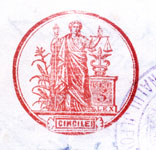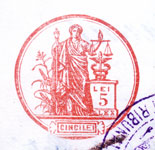| |
 |
Curiosity, error, printing error, fake or joke...!!!??? |
 |
|
 |

Photo 1
|
Going through my personal archive, I stumbled upon a document, common yet curious. The document, which presented a fixed revenue stamp printed in the upper left corner and dated the 2nd of April 1904, on paper with watermark with the royal stamp and the numbers 1904, and which presents in the value field of the fixed 5 lei red stamp a particularity out of the ordinary, the number 5 written with another typographic character (different from the known ones) and the field which usually was empty has a number of at least 28 horizontal ribs which make it difficult to recognize the inscribed value (photo 1).
Having caught my attention, I eagerly looked up all documents from the archive, with the hope that I will find another one similar to the one found, to confirm the existence of a typical variation. No chance. I found documents from the same archive, printed on the same type of watermarked paper, issued by the same institution at a date which does not differ more than a few months, with the same type of fixed

Photo 3 |
stamp, same color and value, 5 lei, but with a different character and the field empty as I have seen up to the present on all documents (photo 2). On absolutely all studied documents, documents which have been taxed by the Ministry of Finance, bills, engraved papers, carriage letters, bonds, shares, passports, etc, from 1870 since 1930, and regardless of the color or the value of the fixed stamp, all value fields are without ribs,

Photo 2 |
empty and for the valor numbers the same font was used. You can observe the differences on the two documents partially reproduced (photo 3). The question remains; is this stamp a mistake, a mould proposed and accidentally introduced in the circuit, is it a fake or a joke.
I ask the readers to help me in solving this enigma. Thank you in advance,
Francisc Ambrus, May 12, 2006
|
 |
 |
Curiozitate, eroare, greşeală de machetare, un fals sau o joacă...!!!??? |
 |
|
 |

Foto 1
|
Umblând prin arhiva personală, am dat peste un document pe cât de comun pe atât de curios. Documentul ce prezintă taxa de timbru fix tipărită în colţul din stânga sus, datat 2 Aprilie 1904, pe hârtie cu filigran stema regală şi cifrele 1904, prezintă în cartuşul valoric al timbrului fix roşu de valoare 5 lei o particularitate ieşită din comun, cifra 5 scrisă cu alt caracter tipografic (diferit de celelalte cunoscute) iar cartuşul care în mod normal era gol are un număr de aproximativ 28 striaţiuni orizontale care îngreunează destul de mult recunoaşterea valorii înscrise (foto-1). Stârnindu-mi curiozitatea, am luat febril la mână toate documentele din arhivă, cu speranţa că voi găsi încă unul asemănator care să-mi confirme existenţa unei variante tipice. Nici o şansă. Am găsit documente provenite din aceeaşi arhivă, imprimate pe acelaşi tip de hârtie filigranată, emise de aceeaşi instituţie la o dată ce nu diferă decât cu câteva luni, cu acelaşi tip de timbru fix, aceeaşi culoare şi valoare, 5 lei, însă caracterul cifrei este diferit iar cartuşul este gol aşa

Foto 3 |
cum am văzut până în prezent la toate documentele (foto-2). La absolut toate documentele studiate, documente ce au fost supuse unei taxe a Ministerului de Finanţe, cambii, coli încrustate, scrisori de trăsură, acţiuni, obligaţiuni, paşapoarte, etc. de la 1870 până la 1930 şi indiferent de culoarea sau valoarea timbrului fix, toate cartuşele valorice sunt fără striaţii, goale şi

Foto 2 |
pentru cifrele valorice s-a folosit acelaşi font. Se poate evidenţia diferenţa pe cele două documente reproduse parţial (foto-3). Rămâne întrebarea, este acest timbru fix o greşeală, o machetă propusă şi intrată accidental în circuit, să fie un fals, o joacă......
Rog cititorii să mă ajute în elucidarea acestei enigme. Mulţumesc anticipat.
Francisc Ambruş, Mai 12, 2006
|
 |
| |

